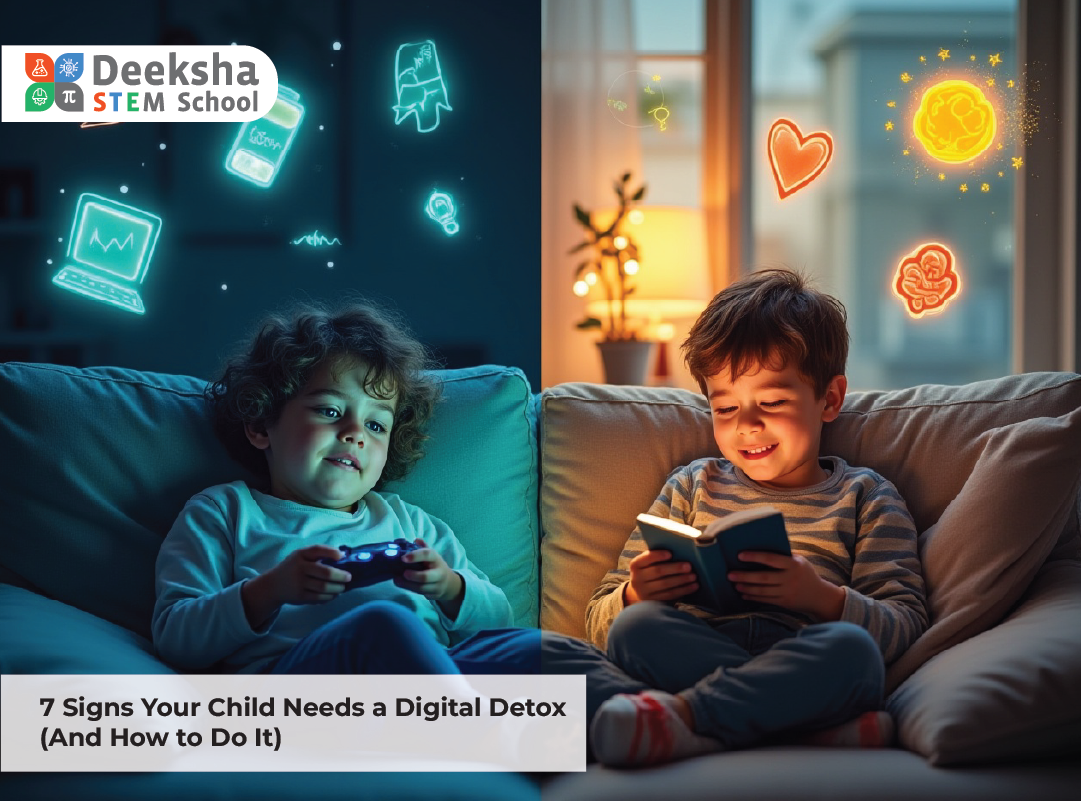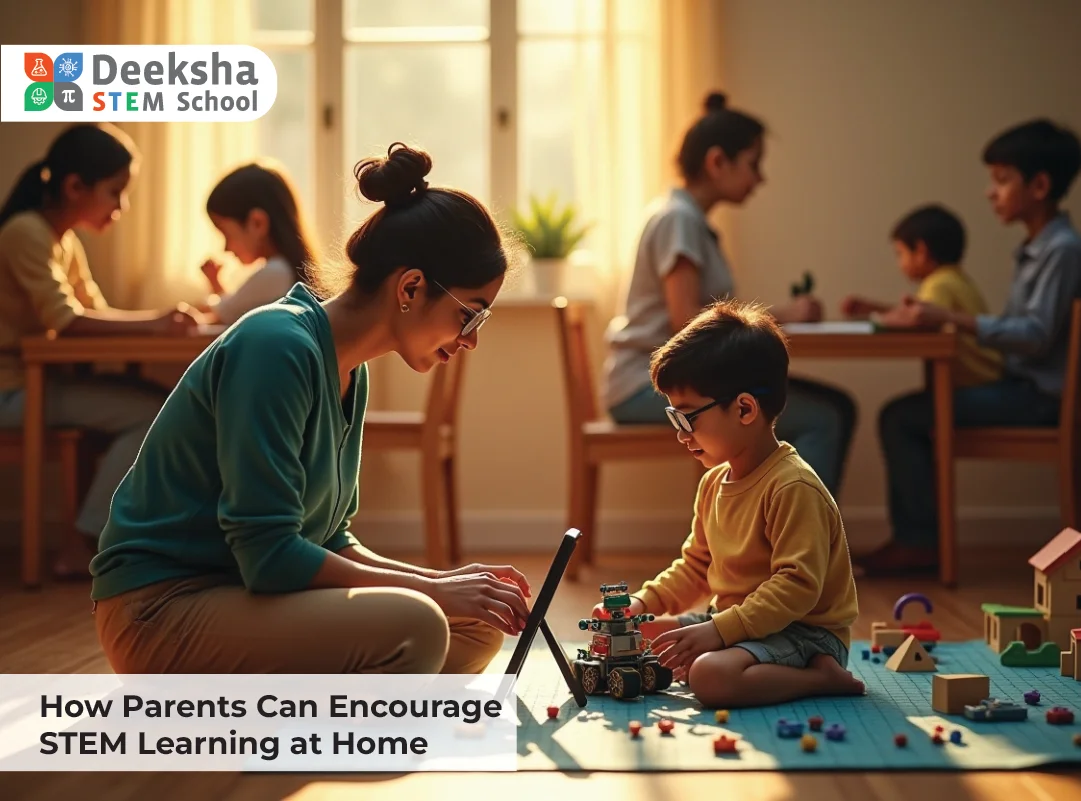7 Signs Your Child Needs a Digital Detox (And How to Do It)

Screens dominate every corner of our lives—from entertainment and education to communication and creativity. Children are growing up in a world where digital access is constant, making it harder to set healthy boundaries. While technology can fuel learning and inspiration, excessive use without guidance can have long-term consequences on mental health, academic performance, and emotional development.
At Deeksha STEM Schools, we value technology as a vital tool in modern education. However, we emphasize intentional usage over passive consumption. By cultivating mindful habits around screens, we empower students to make better decisions in a tech-driven world. Here’s how to identify when your child may be facing screen overload and practical ways to initiate a family-wide digital detox.
7 Signs Your Child May Need a Digital Detox
| Sign | What It Looks Like |
| 1. Irritability or Mood Swings | Your child gets unusually upset or angry when asked to stop using a device or when Wi-Fi is unavailable |
| 2. Sleep Problems | They struggle to fall asleep, stay asleep, or wake up feeling tired—especially after nighttime screen use |
| 3. Declining Academic Performance | Grades may drop or your child may rush through homework to get back to screens, showing loss of focus |
| 4. Loss of Interest in Hobbies | They avoid outdoor games, stop drawing or reading, and don’t engage in previous favorite activities |
| 5. Social Withdrawal | Prefers staying glued to the screen rather than interacting with friends or participating in family events |
| 6. Physical Symptoms | Complaints of dry eyes, headaches, back or neck pain after long screen sessions |
| 7. Obsession with Devices | Constantly asks for screen time, hides devices, or sneaks screen usage even during meals or late at night |
Identifying these signs early allows parents to intervene before screen habits affect a child’s personality, routine, or well-being.
Why Too Much Screen Time Hurts
When screen time goes unchecked, it impacts not just the body, but also the brain and emotions:
- Mental Health Strain: Children may become anxious, socially isolated, or compare themselves to unrealistic portrayals on social media
- Cognitive Overload: The constant switching between apps and tabs reduces concentration and processing power
- Poor Sleep Quality: Blue light suppresses melatonin, which disrupts natural sleep cycles and leads to fatigue
- Lower Academic Engagement: Screen dependency interferes with curiosity, critical thinking, and classroom participation
- Weakened Social and Emotional Intelligence: Children miss out on face-to-face emotional learning and empathy
- Physical Inactivity: Screen time often replaces physical activity, which is crucial for healthy development and mood regulation
Balancing screen time is not about elimination, but moderation—especially in the formative years of growth.
Deeksha STEM’s Approach to Digital Well-being
Deeksha STEM Schools adopt a balanced model that teaches children how to use screens effectively while fostering offline experiences. Our method blends digital exposure with emotional, cognitive, and physical growth:
- Screen-Free Hours: We include time in the daily schedule when no screens are used, encouraging creative play and collaboration
- Mindful Use of Educational Tech: Smart boards and learning platforms are tools, not entertainment. Students use them under teacher guidance
- Digital Citizenship Curriculum: We teach online responsibility, data privacy, digital etiquette, and how to manage screen time wisely
- Wellness Intervals: After digital sessions, students engage in physical exercises, deep breathing, or nature-based breaks
- Hands-On Learning: Activities like robotics, experiments, model-making, and group challenges promote active engagement
This model ensures students become proactive decision-makers in the digital world, not passive screen consumers.
How to Start a Digital Detox at Home
Creating a healthy tech environment doesn’t mean abrupt restrictions—it involves planning, discussion, and consistency:
- Model Good Behavior: Show that you too can disconnect. Read a book, enjoy nature, or play a board game without your phone nearby
- Establish Tech-Free Zones: Avoid using devices in the bedroom, dining table, or during family bonding hours
- Use Digital Well-being Apps: Tools like parental controls, screen time monitors, or usage alerts help enforce boundaries
- Replace Screens with Experiences: Offer alternatives like building puzzles, doing art projects, volunteering, or outdoor challenges
- Create a Screen Schedule: Allow screens only at designated times and stick to it. Build breaks in between long usage periods
- Introduce Reward Systems: Praise and reward effort in offline tasks like journaling, completing chores, or engaging in sports
- Hold Family Challenges: Compete to see who can spend the least time on screens or complete the most screen-free hours each week
- Open Conversations: Encourage your child to talk about what they watch or play and reflect on how it makes them feel
The key is not control but coaching—guiding your child to build awareness and autonomy around screen habits.
Frequently Asked Questions
1. How much screen time is healthy for school-aged children?
- The American Academy of Pediatrics recommends that school-aged children (6–18 years) limit recreational screen time to under 2 hours per day. For educational purposes, breaks should be encouraged every 20–30 minutes.
2. What if my child needs screens for schoolwork?
- Educational screen time is necessary, but ensure it is intentional. Teach your child to take screen breaks, use blue-light filters, and avoid multitasking with social media.
3. My child throws tantrums when I reduce screen time. What can I do?
- Use a phased approach—gradually shorten screen time and introduce positive alternatives. Give advance warnings before turning off screens and make the transition smoother with engaging non-digital activities.
4. Can a digital detox really improve my child’s mood and behavior?
- Yes. Many parents report improved eye contact, more participation in family life, better sleep, reduced anxiety, and renewed interest in hobbies after limiting screen use.
5. How does Deeksha STEM prepare students for responsible tech use?
- We equip students with 21st-century skills and a digital moral compass. Through practical modules, workshops, and classroom norms, we teach how to manage time, use tools wisely, and balance offline interactions with online tasks.
Final Thoughts
Technology is here to stay—but how children engage with it will define their future. Teaching mindful tech usage isn’t about going screen-free—it’s about being screen-smart. Recognizing the signs of digital fatigue and intervening with empathy allows families to cultivate healthier, more aware, and emotionally resilient kids.
At Deeksha STEM Schools, we prepare our learners not just for exams, but for life. We teach them how to navigate digital spaces responsibly, think critically, and live with balance.
Visit our campuses at Bannerghatta Road, Judicial Layout, Kengeri, and Vidyanagar to explore how our mindful learning environment nurtures tech-savvy yet grounded students.




